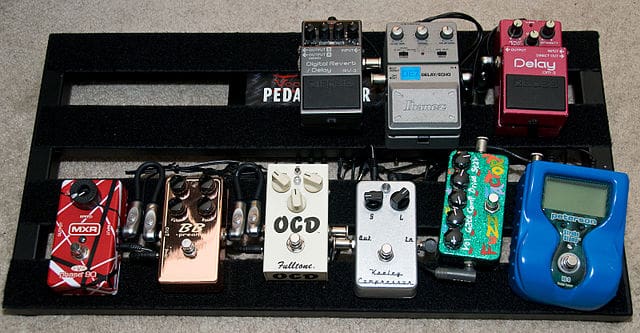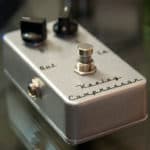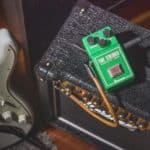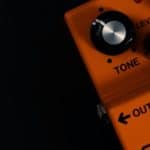Compressor pedals are something a lot of players struggle with.
Their function might be hard to grasp, and how they interact with other pedals in your pedalboard could take a while to make sense of.
Probably, one of the most common questions with regards to them is where you should put them in a pedalboard.
Do they go in front, in the end, or after another particular effect?
Specifically, should you put your compressor pedal before or after your overdrive unit?
Because overdrive effects naturally compress the signal it’s not usual to run a compressor before or after them. Compressors are most commonly used on clean guitar tones to reduce their dynamic range. However, a compressor at the end of the signal chain might help to tidy up and color the tone.
In this article, I will tell you all you need to know about how compressors work, and how their position within your rig might influence their job.
After leaving this page, you will have a clear idea about what is the best place to put your compressor pedal on your pedalboard, and if it matters whether it’s before or after distortion or overdrive.
Are you ready to get started?
Let’s go!
How does a compressor pedal work?
Compressor pedals, such as an audio compressor that comes in any other different format, work by taking the input signal from your guitar and reducing the loudness of any peaks in it to a certain level.
If you are familiar with the concept of dynamic range, compressors work on reducing it.
If you are not familiar with what dynamic range is, it just refers to the differential between your quieter and your louder notes.
A compressor by just squashing your louder notes will leave you with less dynamic output.
And this might sound not that great without any context but think of funk rhythm players or clean country guitarists that rely on consistent strumming.
For some use cases having a tool that just levels out all of your guitar strokes is a godsend.
Of course, compressor pedals are not black boxes that just mess randomly with your tone, they have a certain set of common controls that lets you tweak the depth of the effect.
However, their configuration is a topic that’s out of the scope of this article.
Should you put your compressor pedal before or after overdrive?
Now, the age-old question of where should you place a certain pedal on your pedalboard can always be answered with just an “it depends”, but I’m not feeling that naughty today.
As you can imagine, different players from different backgrounds will have different needs and expectations from their gear.
The common consensus among players is that if you intend on using a compressor for its dynamic range reduction function it should most of the time come in first on your signal chain.
This is, of course, to say you should place it before any kind of overdrive.
However, overdrive and distortion effects are also known for applying some sort of natural compression that might be a big part of their character, and placing a compressor before them will probably ruin this side of them since they will be hit with an already compressed signal.
You should consider if this feature from overdrive pedals is of enough importance to you such as to choose to go without a compressor pedal.
And I’m saying this because if your overdrive works as a compressor, which in varying degrees does, there’s no point in putting a specific pedal for doing so after it.
There will be nothing more to compress.
This is not a binary decision, in any case, because you might like to run a compressor for your clean tones, and then turn it off when you kick in your overdrive.
Finally, for players that like to play a lot with the volume knob of your guitar, and how the difference in signal level increases or reduces saturation from overdrive pedals and amp distortion, putting a compressor before them will make this impossible.
What if you use amp overdrive?
If you are a player that relies on amp overdrive, things are quite similar.
You might want to have a compressor at the beginning of your signal chain for when you play clean tones, as you might probably turn it off when you switch to your amp’s overdriven channel.
Amp’s overdrive and distortion also compress the signal in a similar way as pedals with this function do.
Using a compressor in front of the amp will negate your ability to play with your guitar’s volume knob to clean up or push your amp’s saturation.
Is it wrong to put your compressor later in the signal chain?
Nothing is actually right or wrong in music, and there are many use cases where you might prefer a compressor later in the signal chain.
Some players like having compression kick in at the end of their signal’s travel, even adding it through the amp’s effect loop.
This will give you a similar effect to what studio compressors are commonly used for, just as a way of tidying up and evening out small drifts on your volume.
Of course, this usage is a way subtler one, and perhaps for the more experienced players.
Also, since I mentioned studio compressors, among mixers and audio engineers it’s known that different compressors apart from doing their job also contribute to coloring the tone in particular ways.
So perhaps a compressor later on in your chain might add a certain spice that you couldn’t get otherwise.
Finally, and as you might figure out by now, putting the compressor pedal after your amp’s preamp will enable you to play with your guitar’s volume knob as you would normally do without any compression.
This is, obviously because the compression kicks in right after the point in the chain where your volume modifications alter the tone.
What are the best settings for using a compressor with overdrive?
If you are planning on using a compressor in the way described above just after your amp’s preamp I’d recommend you go with subtle settings.
A slow attack, matched with a not-so-slow release and a not-too-low threshold will do the trick.
Now, when we are talking of using a compressor for your clean tones, and then turning it off to kick in an overdrive or distortion pedal to act as a natural compressor, you might prefer to go with more aggressive settings.
For quick rhythm parts, a faster attack is a must to not “lose” certain notes, a slow release will help you maintain things even together with a low threshold.
Is using a compressor pedal really necessary if you use overdrive or distortion?
Since overdrive and distortion circuits naturally incorporate some compression into the tone, it’s not usual to use them together with compressors on guitar.
Compressors are more commonly used for clean tones.
However, as we discussed, it’s not uncommon to use less impactful compression to finish off the overall sound and to just tidy up things at the end of the signal chain.
This is pretty similar to the usage audio engineers in charge of mixing songs give to compressors on different audio channels, buses, or even the mix master track.

Hello there, my name is Ramiro and I’ve been playing guitar for almost 20 years. I’m obsessed with everything gear-related and I thought it might be worth sharing it. From guitars, pedals, amps, and synths to studio gear and production tips, I hope you find what I post here useful, and I’ll try my best to keep it entertaining also.





